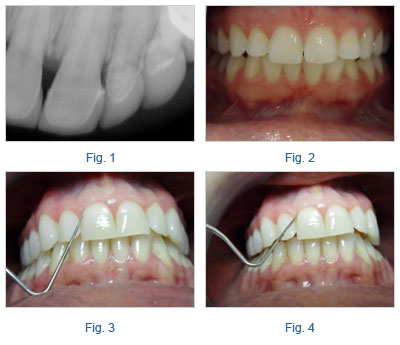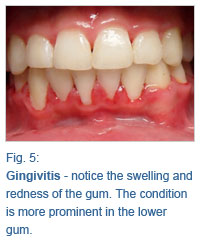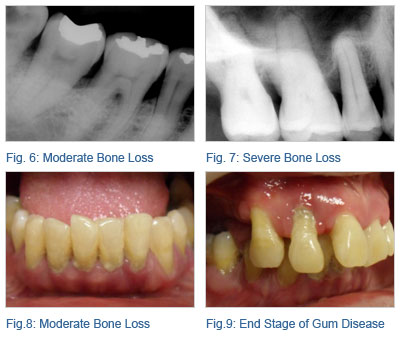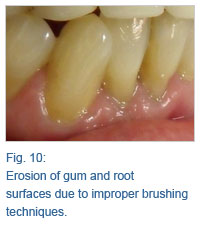Services
Periodontic
To understand periodontal diseases i.e. gum diseases, their treatments and prevention, one must have some knowledge of basic dental morphology.
 Fig. 1 illustrates the thin dark line surrounding each root. This structure is termed the periodontal ligament and it connects the root to the bone, the alveolar process. Covering the alveolar process and onto the crowns is the gum, gingiva. Fig. 2 illustrates that there are two types of gums. The pink, firmed, highly resistance to abrasion type surrounding your crowns termed attached gingival and the more reddish, highly vascularized, easily abraded type adjacent to the attached gingival termed unattached gingiva. Fig. 3 and Fig. 4 illustrate the space between the attached gingiva and the crown extending downward to the bone. This space goes all the way around the tooth and is termed the periodontal pockets. The normal depth of periodontal pockets should be around 1 to 2 mm deep. Maintaining this depth from deepening, which make cleaning much more difficult if not impossible, and free of debris and bacteria is to prevent gum diseases.
Fig. 1 illustrates the thin dark line surrounding each root. This structure is termed the periodontal ligament and it connects the root to the bone, the alveolar process. Covering the alveolar process and onto the crowns is the gum, gingiva. Fig. 2 illustrates that there are two types of gums. The pink, firmed, highly resistance to abrasion type surrounding your crowns termed attached gingival and the more reddish, highly vascularized, easily abraded type adjacent to the attached gingival termed unattached gingiva. Fig. 3 and Fig. 4 illustrate the space between the attached gingiva and the crown extending downward to the bone. This space goes all the way around the tooth and is termed the periodontal pockets. The normal depth of periodontal pockets should be around 1 to 2 mm deep. Maintaining this depth from deepening, which make cleaning much more difficult if not impossible, and free of debris and bacteria is to prevent gum diseases.
Gingival diseases can be divided into two broad categories:
- Dental plaque-induced gingival diseases;
- Non-plaque-induced gingival lesions.
Dental plaque-induced gingival diseases include:
- Gingivitis associated with dental plaque only;
- Gingival diseases modified by systemic factors (the endocrine system, hematologic diseases);
- Gingival diseases modified by medications (phenytoin, an anticonvulsant, cyclosporine, an immunosuppressant, some calcium channel blockers);
- Gingival diseases modified by malnutrition.
Non-plaque-induced gingival lesions are associated with a broad scope of disorders:
- Gingival diseases of specific bacterial origin;
- Gingival diseases of viral origin;
- Gingival diseases of fungal origin;
- Gingival lesions of genetic origin;
- Gingival manifestations of systemic conditions;
- Traumatic lesions;
- Foreign body reactions.
There are other forms of periodontitis that varied in their aggressiveness namely:
- Aggressive periodontitis;
- Necrotizing periodontal diseases
 Without proper flossing one cannot adequately clean the pockets in between teeth. The loose film of debris and bacteria on teeth surfaces is termed dental plaque. If left unclean, plaque will harden onto teeth surfaces via a process of mineralization in as little as 48 hours. Mineralized plaque is termed dental calculus. One can floss and brush away plaque but not calculus. The porous nature of tartar facilitates more formation of tartar on teeth surfaces, a domino effect. Bacteria colonizing these readily made homes produce toxins, which irritate the periodontal tissues i.e. alveolar process, periodontal ligaments, gingiva. The body defense mechanism is then activated. It sent in more support to the areas via an increase in blood supply. This results in swelling of the tissues, gingivitis, Fig.5.
Without proper flossing one cannot adequately clean the pockets in between teeth. The loose film of debris and bacteria on teeth surfaces is termed dental plaque. If left unclean, plaque will harden onto teeth surfaces via a process of mineralization in as little as 48 hours. Mineralized plaque is termed dental calculus. One can floss and brush away plaque but not calculus. The porous nature of tartar facilitates more formation of tartar on teeth surfaces, a domino effect. Bacteria colonizing these readily made homes produce toxins, which irritate the periodontal tissues i.e. alveolar process, periodontal ligaments, gingiva. The body defense mechanism is then activated. It sent in more support to the areas via an increase in blood supply. This results in swelling of the tissues, gingivitis, Fig.5.
 Long - term gingivitis can lead to permanent loss of bone around teeth, periodontitis, Fig.6 and Fig.7. Periodontitis weakens teeth and eventually leads to their loss if left untreated, Fig.9.
Long - term gingivitis can lead to permanent loss of bone around teeth, periodontitis, Fig.6 and Fig.7. Periodontitis weakens teeth and eventually leads to their loss if left untreated, Fig.9.
The danger of periodontitis is of three folds. One, it does not start to hurt until a significant amount of supportive bone is loss. Two, loss of the alveolar process is permanent (Current technology only allowed the regeneration of bone around existing roots in very limited cases). Three, in its early stages, when periodontitis does hurt, the swelling and pain will usually subside all on its own in a few days. This spontaneous disappearance in the disease symptoms allows ignoring it easier. Each cycle of pain, swelling and relief leads to more loss of bone which leads to deeper periodontal pockets which makes all the flossing and brushing ineffective. Thus is the progression of periodontitis.
 On the other end of the spectrum of oral hygiene, improper brushing and flossing can result in lost of gum attachment, bone attachment and erosion of root surfaces, Fig.10.
On the other end of the spectrum of oral hygiene, improper brushing and flossing can result in lost of gum attachment, bone attachment and erosion of root surfaces, Fig.10.
Recognition of gum disease is then the first step in treating gum disease. Answer yes to one or more of the following conditions and one should be evaluated for gum disease (over 75% of adults over the age of 35 have some form of gum disease).
| 01. | Gums look reddish and bleeds easily. |
| 02. | One does not floss before bed time. |
| 03. | One does not floss consistently on a daily basis. |
| 04. | One did not learn to brush and floss properly from a dental professional. |
| 05. | Gums swell up with or without pain. |
| 06. | A permanent tooth feels loose for no apparent reason. |
Treatment of gum diseases is primarily focused on providing an environment where one can adequately and reasonably keep the pockets clean with proper brushing and flossing. Fig.8 shows evidence of tartar adhered to teeth surfaces. Treatment then consists of chipping away and scaling the hard plaque build up above the gum line and planning or smoothing the root surface to remove disease areas to speed healing below the gum line. Depending on how deep the pockets removal of tartar can be done without or with local anesthetics.
When gum disease has progress to the more advance stage, where bone loss caused the deepening to pockets beyond 4mm, intervention now include the reduction of these pockets to their normal range of 1 to 2mm deep and reshaping of the irregular shape of the alveolar process
Guided tissue regeneration and guided bone regeneration are treatment of choice in selected cases.
Prevention of gum disease, when all systemic causes are under control, is hinge upon consistent, proper flossing*(clique to learn how) and brushing*(clique to learn how) in pockets no greater than 4mm and free of tartar buildups. If one skips a few days of flossing, the resulting formation of tartar will not come off ones teeth with any amount of brushing or flossing. The tartar has to be scaled off by your dental professional. Few of us floss / brush consistently and correctly and that is why prevention of gum disease should include regular dental visit.